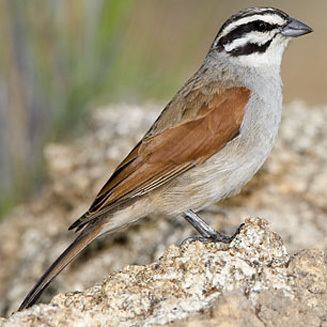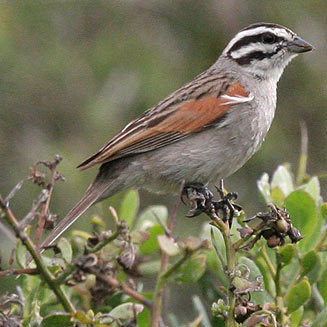Order Passeriformes Genus Emberiza Higher classification Emberiza | Phylum Chordata Family Emberizidae Scientific name Emberiza capensis Rank Species | |
 | ||
Similar Lark‑like bunting, Bird, Cabanis's bunting, Somali bunting, Brown‑rumped bunting | ||
Cape bunting singing
Taxonomy

There are a dozen subspecies, differing in plumage, but all have the distinctive head pattern and rufous in the wings. The north-eastern race E. c. vincenti is very dark above, and slaty below. It has reduced chestnut on the wing coverts. It is now usually raised to species status as Vincent's bunting, Emberiza vincenti, however some taxonomists still consider it to be conspecific.
Description

The Cape bunting is 16 cm long. The adult has a black crown, white supercilium and black-bordered white ear coverts. The upperparts are grey brown with some dark streaks, and the wing coverts are chestnut. The tail is darker chestnut, and the underparts are grey with a pale throat. The sexes are very similar, but females may have a buff tone to the white head markings. Young birds have duller chestnut wings, a less distinct head pattern, and heavier streaking extending on to the breast and flanks. The call is an ascending zzoo-zeh-zee-zee. The song is a loud chirping chup chup chup chup chee chhep chu. E. c. vincenti has a simple tre-re-ret tre-re-ret song.
Distribution and habitat

The Cape bunting occurs in southern Africa from south-western Angola, eastern Zambia, Zimbabwe and southern Tanzania to the Cape. Its habitat is rocky slopes and dry weedy scrub, mainly in mountains in the north of its range. It previously utilized stony arid areas with some short grass, but much of this has been lost to ploughing.
Behaviour

The Cape bunting is not gregarious, and is normally seen alone, in pairs or family groups. It feeds on the ground on seeds, insects and spiders. Its lined cup nest is built low in a shrub or tussock. The two to four eggs are cream and marked with red-brown and lilac.
